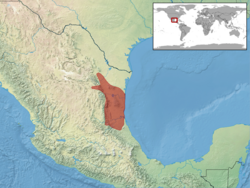Biology:Agkistrodon bilineatus taylori
| Agkistrodon taylori | |
|---|---|

| |
| Scientific classification | |
| Domain: | Eukaryota |
| Kingdom: | Animalia |
| Phylum: | Chordata |
| Class: | Reptilia |
| Order: | Squamata |
| Suborder: | Serpentes |
| Family: | Viperidae |
| Genus: | Agkistrodon |
| Species: | A. taylori
|
| Binomial name | |
| Agkistrodon taylori Burger & Robertson, 1951
| |

| |
| Synonyms[1][2] | |
| |
- Common names: Taylor's cantil,[3] ornate cantil.
Agkistrodon taylori is a venomous pitviper species[4] found only in northeastern Mexico. It is named in honor of American herpetologist Edward Harrison Taylor.[5]
Description
Adults of A. taylori usually attain a total length (including tail) of 64–90 cm (25 1⁄4–35 3⁄8 in), with some growing to 96 cm (37 3⁄4 in). The species has a heavy body and a relatively long tail: 16-19% of total body length in males and 13-18% in females.[6]
Geographic range
A. taylori is native to Mexico, where it occurs in the northeastern states of Nuevo León, San Luis Potosí, and Tamaulipas.[3] The type locality is "21 km north of Villagrán, Tamaulipas, Mexico".[1]
Conservation status
A. taylori is classified as Least Concern (LC) on the IUCN Red List of Threatened Species (v3.1, 2001).[7] Species are listed as such due to their wide distribution, presumed large population, or because it is unlikely to be declining fast enough to qualify for listing in a more threatened category. The population trend is unknown. Year assessed: 2007.[8]
Feeding
A. taylori feeds primarily on rodents and amphibians. Juveniles are known to employ the yellowish tip of their tail as a lure to attract small insectivorous vertebrates. The yellowish tip fades as the animals mature, as does this behavior.
Taxonomy
The subspecies (A. bilineatus taylori ) was elevated to species status (A. taylori ) by Parkinson, Zamudio and Greene (2000) based on mitochondrial DNA sequences.
A. taylori is a vertebrate in the subfamily Crotalinae.
Captivity
Because of their attractive coloration and relatively small size, examples of A. taylori are somewhat popular in the exotic pet trade, with captive bred individuals occasionally being available. The care requirements are fairly basic, similar to A. contortrix. These snakes are, however, not for the inexperienced keeper. The venom of A. taylori is significantly stronger than that of A. contortrix and can cause severe tissue damage and even death if untreated. Dry bites are seldom reported, and these snakes may strike repeatedly.
See also
- List of crotaline species and subspecies
- Crotalinae by common name
- Crotalinae by taxonomic synonyms
- Snakebite
References
- ↑ 1.0 1.1 McDiarmid RW, Campbell JA, Touré TA (1999). Snake Species of the World: A Taxonomic and Geographic Reference, Volume 1. Washington, District of Columbia: Herpetologists' League. 511 pp. ISBN:1-893777-00-6 (series). ISBN:1-893777-01-4 (volume).
- ↑ "Agkistrodon taylori ". The Reptile Database. www.reptile-database.org.
- ↑ 3.0 3.1 Gloyd HK, Conant R (1990). Snakes of the Agkistrodon Complex: A Monographic Review. Society for the Study of Amphibians and Reptiles. 614 pp. 52 plates. LCCN 89-50342. ISBN:0-916984-20-6.
- ↑ "Agkistrodon bilineatus taylori ". Integrated Taxonomic Information System. https://www.itis.gov/servlet/SingleRpt/SingleRpt?search_topic=TSN&search_value=586229. Retrieved 2 November 2006.
- ↑ Beolens, Bo; Watkins, Michael; Grayson, Michael (2011). The Eponym Dictionary of Reptiles. Baltimore: Johns Hopkins University Press. xiii + 296 pp. ISBN:978-1-4214-0135-5. (Agkistrodon bilineatus taylori, p. 261).
- ↑ Campbell JA, Lamar WW (2004). The Venomous Reptiles of the Western Hemisphere. Ithaca and London: Comstock Publishing Associates. 870 pp. 1500 plates. ISBN:0-8014-4141-2.
- ↑ Lavin P, Mendoza-Quijano F, Hammerson GA (2007). Agkistrodon taylori. The IUCN Red List of Threatened Species. Version 2014.3. Downloaded on 13 April 2015.
- ↑ 2001 Categories & Criteria (version 3.1) at the IUCN Red List. Accessed 14 September 2007.
Further reading
- Burger WL, Robertson WB (1951). "A New Subspecies of the Mexican Moccasin, Agkistrodon bilineatus ". Univ. Kansas Sci. Bull. 34 (1): 213-218. (Agkistrodon bilineatus taylori, new subspecies).
- Parkinson CL, Zamudio KR, Greene HW (2000). "Phylogeography of the pitviper clade Agkistrodon: historical ecology, species status, and conservation of the cantils". Mol. Ecol. 9: 411-420.
External links
| Wikimedia Commons has media related to Agkistrodon bilineatus. |
- Agkistrodon taylori at the Reptarium.cz Reptile Database. Accessed 7 December 2007.
Wikidata ☰ Q310814 entry



